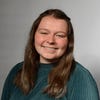August 24, 2023

A team of Purdue University professors and researchers may have found a partial solution to early embryo death in replacement heifers. Through the help of the Super SmartFeed, the group found that providing supplements early in the grazing season may be the missing link to this problem.
The Super SmartFeed is a feeder system that weighs and distributes feed to individual animals based on an RFID tag in their ear. It is manufactured by C-Lock Inc. in South Dakota, and there is an economy model for producers.
“Picture this as a really fancy creep feeder that has scales on it,” says Nick Minton, Purdue beef systems specialist. “We’re able to control animal intake by way of an app or logging online.”
The feeder was acquired in part through Purdue College of Agriculture’s internal Agricultural Science and Extension for Economic Development grant program, or AgSEED, which is supported by funds from the Indiana Legislature as part of the Crossroads program. Researchers have worked to obtain one of these feeders, and Ron Lemenager, Purdue Extension beef specialist, was able to secure the funding for the feeder. Additional support for the research project was provided by the Indiana Soybean Alliance.
Current research
The research team recently wrapped up their first project with the Super SmartFeed; this project aimed to discover how supplemental feed could affect embryo survival rates for replacement heifers on early grazing season pasture.
“The Super SmartFeed gives us the opportunity to use individual animals as our experimental unit instead of having to do a pasture as the experimental unit,” Lemenager says. “The ability to conduct research that would be peer-reviewed and published has taken a quantum leap by this piece of equipment.”
There were 62 heifers observed in this project, and half were given the supplemental feed from time of breeding to 45 days post-breeding, while the other half was the control group and received no supplemental feed. Those that received feed were given 5 pounds of pelleted soybean hulls daily while the feeder distributed and tracked how much each animal consumed. Weight and other measurements such as reproductive tract score and body condition score were taken throughout the experiment.

IN USE: Two heifers are lined up at the Super SmartFeed. The research tool distributes allotted amounts of feed based on each heifer’s RFID tag. (Photo by Griffin Nicholls)
Controlled intravaginal drug release devices (CIDRs) were inserted into all the heifers prior to breeding, and they were all initially bred by timed artificial insemination. Clean-up bulls were turned out onto the pasture after AI breeding. The heifers were bred earlier than other cows to allow another estrous cycle, if needed.
“What we’re really interested in is how many of those heifers conceived during that first service, regardless of season-long conception,” says Griffin Nicholls, a graduate student in animal sciences. “This is because previous literature has shown that heifers that calve early in their first breeding season will continue to calve earlier in subsequent calving seasons throughout their productive lifetime, ultimately improving herd profitability.”
Promising results
At the conclusion of the experiment, 96% of the heifers provided supplemental feed were pregnant, while only 84% of the control group heifers were pregnant. Broken down further, the experimental group of heifers had an AI conception rate of 64%, and the control group had an AI conception rate of 44%. While numbers are encouraging, results are still preliminary.
“This study needs to be repeated to give us increased numbers to be able to pick up the statistical significance that we think is there based on this preliminary data,” Lemenager explains.

CURIOUS GROUP: The project heifers were not shy when it came to inspecting the feeder. Prior to the experiment, they were trained to use the feeder so there would not be any problems with the project. (Photo by Jason Tower)
The next step would be creating studies that cut down on the timeframe for supplementing feed to a critical window for optimizing the early grazing season AI breeding results.
“If we could minimize that supplementation period to maybe 14 days without having early embryo death, now that really shortens up your feeding period and the cost factor,” Lemenager says. “So, we’re not done yet.”
Implications for producers
While this first study with the Super SmartFeed does not provide concrete evidence that feed supplements can increase embryo survival rates, it does provide a new option for beef producers to experiment with on their own operations. Producers can provide feed to their replacement heifers at the beginning of their pregnancy to potentially yield higher conception and survival rates.
As previously mentioned, there is also a producer model of the Super SmartFeed available. A full lineup of products can be found at c-lockinc.com. However, if SmartFeed systems are not in the budget, information captured with their assistance can still impact your operation.
“From a research standpoint, this machine and equipment allows us to be able to be much more precise in identifying animal responses to strategic supplementation strategies,” Lemenager says. “Ultimately, we believe our recommendation will be to group-feed a supplement to heifers as a group in a feed bunk to obtain similar results.”
This research would not be possible without the help of many hands throughout the process: Ron Lemenager; Griffin Nicholls; Nick Minton; Keith Johnson, Purdue Extension forage specialist; Bethany Funnel, Purdue Extension beef veterinarian; Ophelia Davis, Lawrence County, Ind., Extension educator; Jason Tower, Southern Indiana Ag Center superintendent; Brad Shelton, Feldun-Purdue Ag Center superintendent; and staff of the Feldun-Purdue Ag Center, including Roger Bartlett, Sam Perry Jr., Levi Wright and Aaron Keiser.
About the Author(s)
You May Also Like






